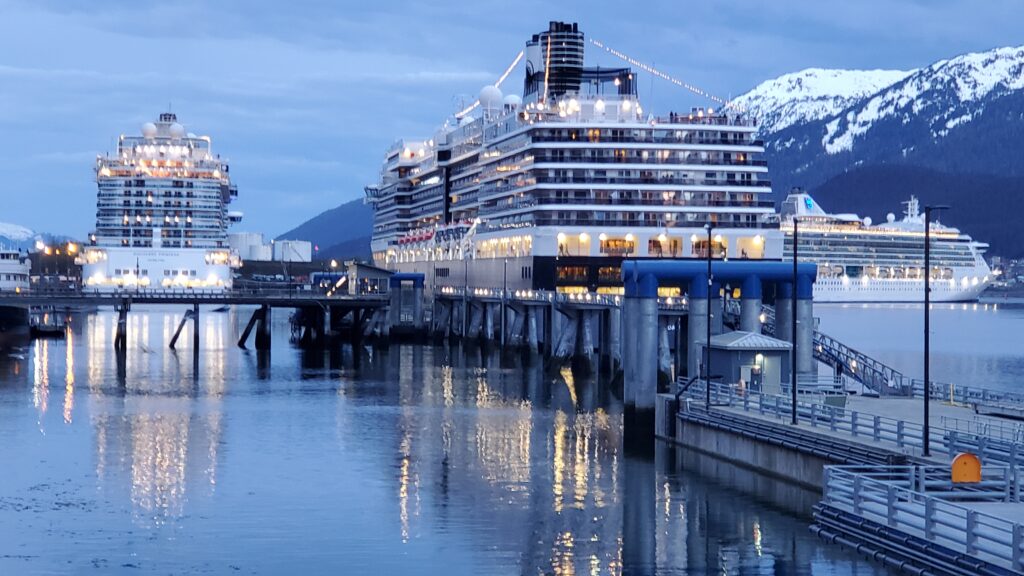Lights from cruise ships are reflected on the surface of downtown Juneau’s harbor on the evening of May 10. (Photo by Yereth Rosen/Alaska Beacon)
Scrubbers, most of which use seawater to rinse some pollutants out of the ship’s exhaust, may sound like a good thing because they take sulfur and other pollutants from burning fossil fuels out of the air — but don’t be fooled. Exhaust Gas Cleaning Systems (EGCS) on ships, colloquially known as scrubbers, transfer enormous amounts of extremely toxic pollution from the air into our oceans.
Rather than using more expensive, cleaner fuels, the shipping industry has turned to scrubber technology to comply with sulfur limits intended to protect human health and the environment, but which are causing unacceptable results.
A growing body of scientific evidence, summarized in a recent report by Pacific Environment, reveals that there is no safe concentration of scrubber effluent, which negatively affects organisms throughout the marine food chain. Impacts to the marine web of life include harmful effects on tiny crustaceans and microplanktonic species that are the main food source for endangered species like Southern Resident killer whales.
Scrubbers have been used in Southeast Alaska waters for more than a decade, following the establishment of the North American Emission Control Area in 2012 and subsequent EPA action to limit the sulfur content of marine fuels used there to .1%. Use of scrubber technology to meet low-sulfur fuel requirements has continued to grow in Alaska and globally, recently exploding upward when the International Maritime Organization in 2020 lowered the sulfur fuel content limits from 3.5% to .5%, except for ships that have an EGCS.
Today, around 4,600 ships worldwide use scrubbers, including container ships, cruise ships, bulk carriers and oil tankers. In 2011, that figure was 12.
Cruise ships are among the largest scrubber polluters, accounting for about 15% of scrubber discharge worldwide. In Alaska, a major cruise destination, scrubber discharges heavily impact the waters of Southeast Alaska’s Inside Passage as well as communities and all around Alaska’s 6,640 miles of coastline, where cruise traffic is expanding farther west and north as the Arctic Ocean’s ice packs melt and recede.
Cruise ships discharge an estimated 6.3 to 8.7 million gallons of scrubber waste per day from one medium-sized ship (and that’s just a medium-sized ship – just recently Carnival announced that it will build three of the largest ships ever).
So-called “open loop” scrubbers, the most widely used type, constantly discharge enormous amounts of acidic water containing polycyclic aromatic hydrocarbons (PAHs), particulate matter, nitrates, nitrites and heavy metals including nickel, lead, copper and mercury. These pollutants are discharged into the marine environment where they can damage ecosystems and wildlife and worsen water quality.
Because of documented harm to the marine environment, more than 90 localities, ports, regions and countries, most recently Denmark and Sweden, have acted to ban or regulate scrubber discharges. The United States should follow their lead.
The solution is for ships to burn cleaner distillate fuel, which eliminates the need for scrubbers. Since this isn’t being done voluntarily by industry, government action is urgently needed to protect the health of our oceans.
Pacific Environment, the Southeast Alaska Conservation Council and Alaska Community Action on Toxics are hosting a webinar on scrubbers at noon Alaska Standard Time on Sept. 19. Register here to attend and learn more.
This article was first published by the Alaska Beacon, part of States Newsroom, a nonprofit news network supported by grants and a coalition of donors as a 501c(3) public charity. Alaska Beacon maintains editorial independence. Contact Editor Andrew Kitchenman for questions: info@alaskabeacon.com. Follow Alaska Beacon on Facebook and X.

